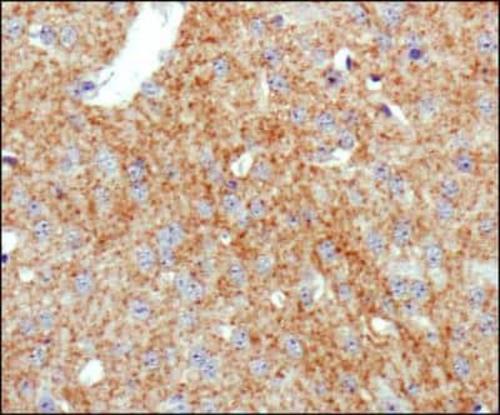Dopamine Transporter (SLC6A3) Mouse Monoclonal Antibody [Clone ID: mAb16]
Frequently bought together (1)
Other products for "Dopamine Transporter"
Specifications
| Product Data | |
| Clone Name | mAb16 |
| Applications | IHC, WB |
| Recommended Dilution | Immunoprecipitation, Immunohistochemistry-Paraffin: 1:100, ELISA, Immunohistochemistry: 1:100, Immunocytochemistry/ Immunofluorescence: 1:250, Western Blot: 1:1000 |
| Reactivities | Mouse, Rat (Does not react with: Human) |
| Host | Mouse |
| Isotype | IgG1 |
| Clonality | Monoclonal |
| Immunogen | Synthetic peptide corresponding to the N-terminus of rat DAT1. [UniProt# P23977] |
| Formulation | PBS containing 0.05% BSA, 0.05% Sodium Azide. Store at 4C short term. Aliquot and store at -20C long term. Avoid freeze-thaw cycles. |
| Concentration | lot specific |
| Purification | Protein G purified |
| Conjugation | Unconjugated |
| Storage | Store at -20°C as received. |
| Stability | Stable for 12 months from date of receipt. |
| Gene Name | solute carrier family 6 member 3 |
| Database Link | |
| Background | DAT1, also known as SLC6A3 and Sodium-dependent dopamine transporter, is a sodium and chloride-dependent dopamine transporter belonging to the solute carrier family 6. Dopamine transporters are distributed widely across the brain in regions with high dopaminergic activity, such as the striatum and substantia nigra. These transporters effectively provide fast acting clearance of dopamine, adrenalin and noradrenalin from the synaptic cleft, thus terminating the neurotransmitter signal. DATs have been found to interact with PRKCABP, TGFB1I1, SLC18A2 and the N-terminus of SYNGR3. DATs are also the target proteins for psychomotor stimulants such as amphetamines and cocaine. Research has implicated DATs as useful markers in detecting depression, schizophrenia, Parkinson's disease and drug abuse (Kish et al., 2001; Zhu et al., 2000; Zhu et al., 1999). |
| Synonyms | DAT; DAT1; PKDYS |
| Note | This DAT1 (mAb16) antibody is useful for Western blot, Immunocytochemistry/Immunofluorescence, Immunohistochemistry on paraffin-embedded sections and ELISA. In WB a band can been seen at ~70-85 kDa. Use in Immunoprecipitation reported in scientific literature (PMID: 20643191). |
| Reference Data | |
| Protein Families | Druggable Genome, Transmembrane |
| Protein Pathways | Parkinson's disease |
Documents
| Product Manuals |
| FAQs |
| SDS |
{0} Product Review(s)
0 Product Review(s)
Submit review
Be the first one to submit a review
Product Citations
*Delivery time may vary from web posted schedule. Occasional delays may occur due to unforeseen
complexities in the preparation of your product. International customers may expect an additional 1-2 weeks
in shipping.






























































































































































































































































 Germany
Germany
 Japan
Japan
 United Kingdom
United Kingdom
 China
China





